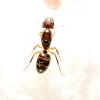1. Location of collection: Newark, NJ
2. Date of collection: 5/15/2017
3. Habitat of collection: inside of a house in urban area
4. Length (from head to gaster): approximately 5-6mm
5. Color, hue, pattern and texture: black with yellowish stripes around gaster
6. Distinguishing characteristics: none observed
7. Distinguishing behavior: Seems relatively calm, even when exposed to light or otherwise disturbed
8. Nest description: Unsure, as she was found on the wall inside of my house
Edited by Deleran, May 25 2017 - 6:42 PM.















